Missionary Travels in Pen & Print (1)
Cite (MLA): Livingstone, Justin D. "Missionary Travels in Pen & Print (1)." Jared McDonald and Adrian S. Wisnicki, eds. In Livingstone's Missionary Travels Manuscript. Justin D. Livingstone and Adrian S. Wisnicki, dirs. Livingstone Online. Adrian S. Wisnicki and Megan Ward, dirs. 2019. Web. http://livingstoneonline.org/uuid/node/271675c1-0287-4676-a1df-2d260da91176.
This page, the first of a two-part essay, engages in comparative analysis of Livingstone’s Missionary Travels in manuscript (1857bb, 1857cc, 1857dd) and published form (1857aa). In doing so, it identifies two major patterns of revision and redaction that occurred between draft and print. First, the essay demonstrates that Missionary Travels was subject to a process of sanitisation following the conventions of polite publishing; through this process, content that a genteel audience might have considered vulgar or improper was excised before publication. Second, the essay argues that redactions of contentious material on the Transvaal Voortrekkers and the Cape Frontier Wars served to depoliticize the book in the interests of avoiding public controversy. Read the second part of the essay here.
1. Introduction Top⤴
When Livingstone drafted the first chapter of Missionary Travels (1857), he followed the remarks on his early "life of toil" and "hardy training" in Blantyre Mill with some extended discussion of Scottish workers and industrial labour (Livingstone 1857bb:[16]-[18], cf. 1857aa:6). Although many of the comments are moderate in substance, and devoted to rejecting the claim that factory life was one "of white slavery," Livingstone's enthusiastic identification with the working classes is highly conspicuous. As he declared, "the warmest sympathies of my heart being with the English and Scottish poor I would denounce any oppression in them no matter by whom practised" (Livingstone 1857bb:[16]).

Livingstone’s Birthplace at Blantyre, from a Sketch by the Author. Illustration from R.B. Dawson, Livingstone the Hero of Africa (London: Seely, Service & Co., 1918), opposite 32. Courtesy of the Internet Archive. Livingstone’s working class background has been romanticized by many of his biographers, who have presented him as an exemplar of Victorian self-improvement. This artistic rendering of Livingstone’s family home, which was tenement housing provided for Blantyre cotton mill employees, participates in such romanticization through an idealized depiction of workers’ living quarters in nineteenth-century industrial Scotland.
Had Livingstone's comments remained intact for the published book, they could have raised questions about his political convictions and provoked charges of sympathy with the radical lobby for economic and social reform. In the discussion, Livingstone complains that factory wages are "often far too low" and goes so far as to warn employers against exploitation with the threat of collective proletarian action: "If slavery were attempted to be imposed on such people no human power could restrain their vengeance" (1857bb:[16], [18]). Despite Livingstone's assurance (which appears in both manuscript and print) that "[t]he masses of the working people [...] are no revolutionary levellers" (1857bb:[18], cf. 1857aa:7), his commentary on industrial conditions and a politically engaged working class risked alienating the establishment whose support he required for future ventures.
This discussion, however, never made it to print. Such a conspicuous excision – and its clear political rationale – sheds light on the editorial process by which Livingstone's manuscript became a published narrative. This act of redaction is just one of the countless instances of revision that shaped Missionary Travels in critical ways, but it signals the extent to which authorial reputation and persona were critical issues for both Livingstone and his publisher John Murray III (the third in a publishing dynasty; hereafter "John Murray") as they sought to navigate the literary market.
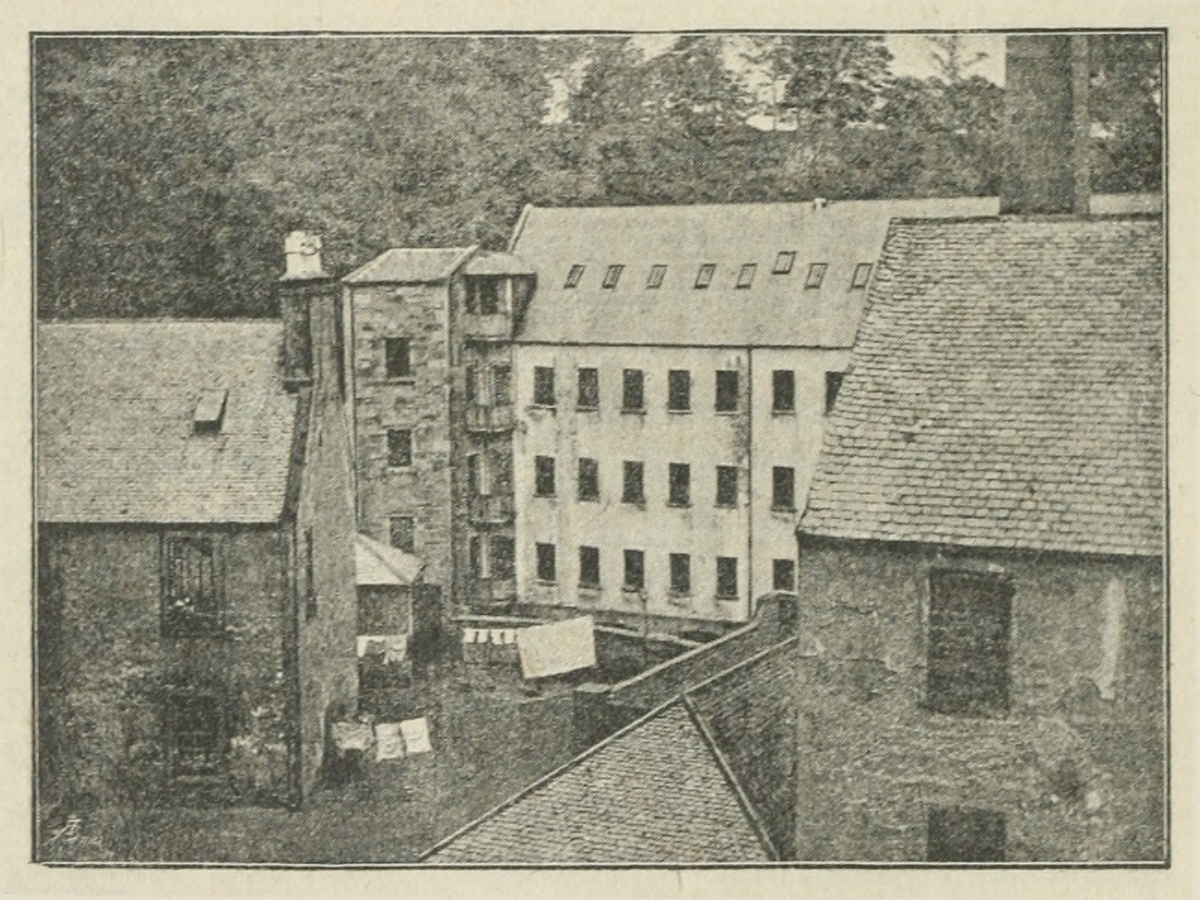
Factory at Blantyre. Illustration from H. H. Johnston, Livingstone and the Exploration of Central Africa (London: George Philip & Son, 1891), 56. Courtesy of the Internet Archive. This reproduction of a nineteenth-century photograph of Blantyre provides a more sobering representation of the working conditions of Livingstone’s early life when compared to Dawson's more artistic rendering (see prior image).
This essay offers the first sustained analysis of the Missionary Travels manuscript (Livingstone 1857bb, 1857cc, 1857dd) alongside the published book (1857aa). By so doing, the aim is to disclose the critical significance of key transformations that occurred between Livingstone's first and final draft. While examining major redactions and seemingly minor interventions, the essay does not attempt to offer an exhaustive list of discrepancies but instead identifies and analyses the two dominant patterns of revision that characterised the transition from manuscript to print.
In the first place, this essay shows that Missionary Travels was refined and sanitised according to the literary conventions of polite publishing, which prevented the publication of potentially embarrassing content. Secondly, and more significantly, the essay reveals that redactions of contentious material on the Transvaal Voortrekkers and the Cape Frontier Wars ensured that the book was also significantly depoliticized prior to publication. The original manuscript reveals that Livingstone was strikingly forthright in criticising settlers in the Transvaal and the Eastern Cape, in questioning colonial policies, and in voicing support for African land rights. However these initial aims, some of which were quite radical, were ultimately curtailed in the published version in consideration of the book's prospective audiences.
2. Sanitization: The Protocols of Politesse Top⤴
Perhaps the most conspicuous transformations between Livingstone's manuscript and published work involved issues of politesse. Missionary Travels, like other John Murray travel books, was scrutinised according to the publisher's protocols of decency and decorum. Livingstone was writing, of course, during a period in which the Victorian cult of "respectability" held sway; heavily influenced by early nineteenth-century evangelicalism, the norms of middle-class propriety had become dominant in the 1840s and played a significant role in regulating public expression (Huggins 2000:586, Dawson 2007:4).
The John Murray house certainly upheld the discourse of respectability. In the context of concerns about the moral influence of cheap and popular literature, which burgeoned in the Victorian era, the firm had cultivated a reputation as a "gentleman's publishers" of considerable moral rectitude (Keighren, Withers, and Bell 2015:195-96). When it came to the works of explorers, many of whom had encountered much on their journeys that would not make suitable reading matter for a domestic audience, the publisher was careful to ensure that standards of respectability and morality were upheld. Bringing travel texts to print thus involved subjecting manuscripts to "regulatory practices" of "taste" in order to cater for the expectations of a polite audience (Bell 2013:10).
| (Left; top in mobile) Victoria Falls. (Right; bottom) Livingstone Sees the Queen. Images from Lantern Slides of the Life, Adventures, and Work of David Livingstone (London Missionary Society c.1900:[3]-[4]). Images courtesy of the Smithsonian Libraries, Washington, D.C. The London Missionary Society participated in cultivating Livingstone’s posthumous reputation by producing a series of thirty-nine magic lantern slides depicting iconic moments from his life. The inclusion of Livingstone’s audience with Queen Victoria, shown here alongside a representation of Victoria Falls (Livingstone's greatest "discovery" as an explorer, which he named after Queen Victoria), suggests that propriety and respectability were characteristics that the London Missionary Society – like the John Murray publishing house – aimed to associate with its representatives. |
As an agent of the London Missionary Society, Livingstone was familiar with the conventions of missionary publishing and well equipped to self-regulate his publication. Yet the John Murray firm took considerable care in cultivating the public image of its authors and found much in Missionary Travels to query and revise in spite of Livingstone's evangelical sensibilities. Indeed, as the next section argues, the publisher's reader scrutinised the manuscript for material that might test the parameters of respectability or lead to reputational damage for either author or publisher.
▲ 2.1. Vulgarity, Sex, and the Body
It was Murray's reader, John Milton, who was responsible for addressing issues of politesse as he reviewed and corrected Missionary Travels (for more on Milton, see Composing & Publishing Missionary Travels [2]). Milton's role involved marking up Livingstone's manuscript in red ink in order to sanitize language that could be considered vulgar. To give one representative example, Milton was quick to query Livingstone's reference to the "urine of the chukuru" and to suggest "the water" instead as a more polite alternative (1857bb:[183]).
For the same reasons, Milton would occasionally highlight anecdotes and recommend their revision or excision. One amusing case concerns Livingstone's description of the methods of the Kalahari San for storing and hiding water in desert conditions. In both manuscript and publication (Livingstone 1857bb[109]-[110], 1857aa:52), Livingstone recounts how a BaKwena party attempted to compel the San to share their supply, but failed to do so and was eventually repelled by thirst. In the manuscript, however, Livingstone remarks that the BaKwena's vigil ended when they eventually saw water "come forth," although not quite in the manner expected. Instead of receiving water to drink, they witnessed the San relieving themselves: "to their horror they saw it stream from the Kidney[.] Up started the Bakwain exclaiming ‘Yak, yak! these are not men'" (Livingstone 1857 bb:[110]).
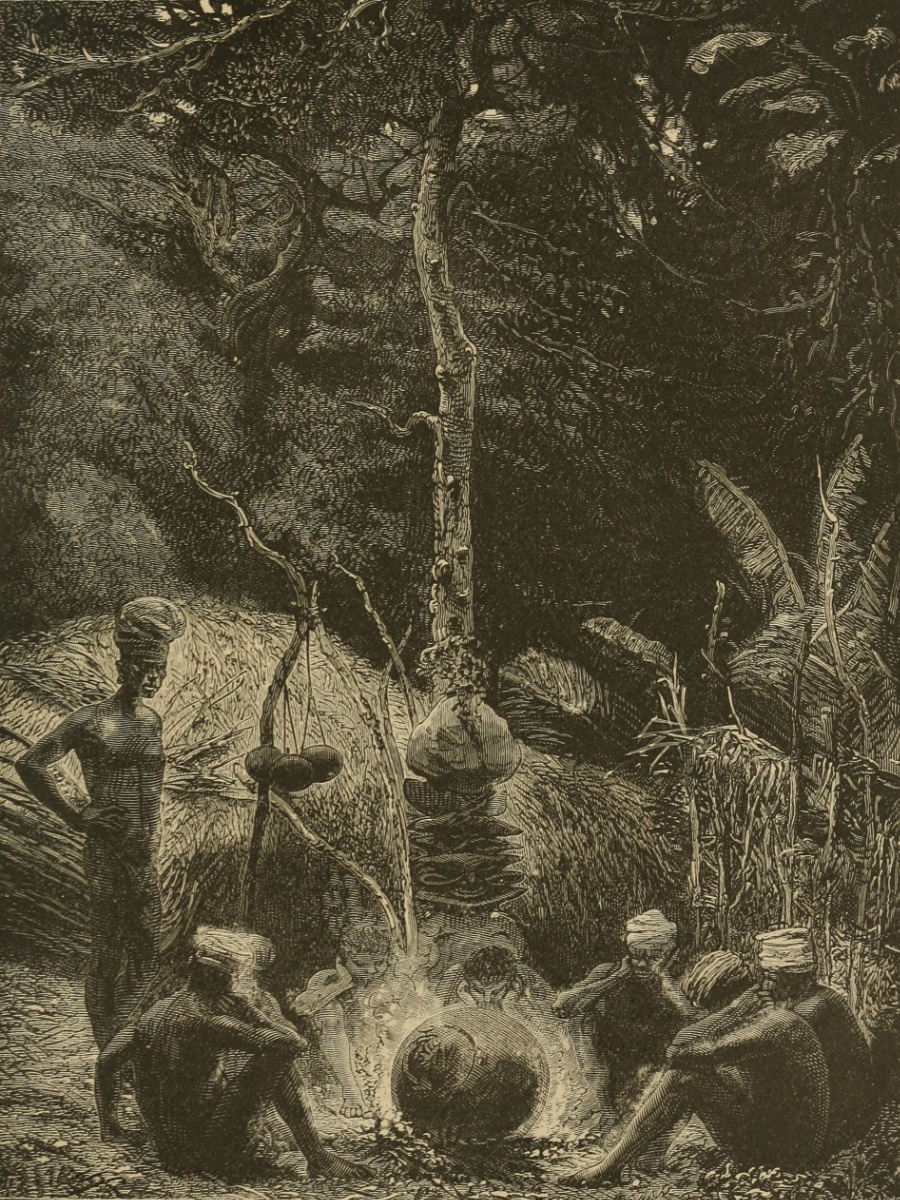
Bushman’s Camp. Illustration from J. E. Chambliss, The Life and Labors of David Livingstone, LL.D., D.C.L. (Philadelphia, Boston, and Cincinnati: Hubbard Bros., 1875), 69. Courtesy of the Internet Archive. The indigenous hunter-gatherer peoples of southern Africa, collectively known as the San (historically “Bushmen,” now a pejorative term), became the subject of much speculative evolutionary science when descriptions began to circulate from the 1840s onward in the wake of European travel through the Kalahari. This illustration demonstrates how the San’s semi-nomadic lifestyle could attract racial stereotyping in nineteenth-century publications.
The editor's response is to bracket this report in red ink, mark it twice with the marginal comment "omit," and to indicate that the story is less than "decent" (Livingstone 1857bb:[109]-[110]). Clearly, such an explicit reference to bodily functions would not do. In the published version, the anecdote remains but is altogether stripped of its amusing and risqué allusion: "[N]otwithstanding their watchfulness, kept alive by most tormenting thirst, the Bakwains were compelled to exclaim, ‘Yak! yak! These are not men" (Livingstone 1857aa:52).
This sort of redaction is characteristic of a wider pattern of revision that occurs not only in the manuscript mark up, but also at the galley proof stage. Livingstone's reference to the "urine of the mountain coney" may be left intact in the manuscript, for instance, but it appears in publication as the less indecorous "renal deposit" (1857bb:[47], 1857aa:22). Likewise, his scatological reference to the "droppings of a bull" is rendered in print as the more discreet "animal deposit" (Livingstone 1857bb:[316], 1857aa:128). Taken together, such seemingly innocuous and even trivial interventions amount to a general sanitization, one that occurred at multiple stages of the publication process.
Other redactions made in the interest of decorum may well have spared Livingstone and Murray later embarrassment. This is certainly the case with material of a bodily or sexual nature, which often attracted Milton's comment and correction. In one of the more conspicuous examples (found in a description of Makololo attire), Livingstone's forthright remarks about the "exposed" and "large pendant breasts" of the women – which might have seemed voyeuristic – are struck out in red (1857cc:[71]).
![Image of a page segment from the Missionary Travels manuscript (Livingstone 1857cc:[71]), detail. Copyright National Library of Scotland and Dr. Neil Imray Livingstone Wilson (as relevant). Creative Commons Share-alike 2.5 UK: Scotland (https://creativecommons.org/licenses/by-nc-sa/2.5/scotland/). Image of a page segment from the Missionary Travels manuscript (Livingstone 1857cc:[71]), detail. Copyright National Library of Scotland and Dr. Neil Imray Livingstone Wilson (as relevant). Creative Commons Share-alike 2.5 UK: Scotland (https://creativecommons.org/licenses/by-nc-sa/2.5/scotland/).](/sites/default/files/in-his-own-words/missionary-travels-manuscript/missionary-travels-in-pen-and-print-1/liv_000100_0071-article-crop-1200.jpg)
Images of two page segments from the Missionary Travels manuscript (Livingstone 1857bb[312], 1857cc:[71]), detail in both cases. Copyright National Library of Scotland and Dr. Neil Imray Livingstone Wilson (as relevant). Creative Commons Share-alike 2.5 UK: Scotland. These segments show editorial redactions to Livingstone's statements about female anatomy that might have been regarded as improper by a polite readership.
The editor was most concerned when remarks implied the author's involvement in close bodily inspection. In one fulsome discussion of BaTswana breastfeeding practices, for instance, where Livingstone claims to have witnessed older women suckling their grandchildren, Milton deletes an explicit reference to the "examination" of their "bluish" breast milk (1857bb:[312]).
As a trained physician, who regarded medical practice as part of his missionary vocation, Livingstone apparently felt that such subjects fell within his remit. But in the nineteenth century, such open discussion tended to be reserved for medical and scientific journals where the intended readership was restricted to fellow practitioners (Dawson 2007:118). Milton thus recommended excising obstetric and gynaecological material (Livingstone 1857bb:[328], 1857cc:[68]), comments on BaKwena sexual practice during maternity (1857bb:[236]), and even Livingstone's brief gloss of a report published in the British Foreign and Medical Review for its reference to breast "inflammation" and "sore nipples" (1857bb:[314]).
Clearly, Milton was highly sensitive to statements that may have been fitting matter in other venues, but not in a Murray travel book. Where Livingstone's medical and ethnographic interests took him into territory that might disconcert readers or attract charges of prurience, it was Milton's task to intervene. Preparing the Missionary Travels manuscript for print, then, involved ensuring that the text would not risk disturbing the sensitivities of British polite culture.
▲ 2.2. Livingstone and Literary Propriety
As explored elsewhere in the present edition, there were certainly aspects of the editorial process that provoked Livingstone's ire (see Composing & Publishing Missionary Travels [1]). For the most part, however, he cooperated as his book was filtered through the publisher's protocols of politesse.
Livingstone didn't protest, for instance, when Milton queried his description of the Griqua and individuals of mixed race as "Bastards" (1857bb:[254], 1857cc:[157]). This ethnonym, which was derived from the Dutch word "bastaard," had been used in the Cape Colony since the eighteenth century for social groups of heterogeneous racial origin (Legassick 2010:46-47, Cavanagh 2011:xi). The term did not necessarily imply illegitimacy in this context (although it implicitly carried this connotation), but some missionaries did regard it as derogatory (Traill 1995:8, Johnson 2012:166). When Milton objected to the term, presumably on the basis that readers would find it offensive, Livingstone complied with its excision.

Mr. Moffat Exhorting the Children of the Chief Sechele. Illustration from Missionary Magazine and Chronicle, December 1854, 255. Courtesy of the Internet Archive. Robert Moffat, who later became Livingstone’s father-in-law and served as one of his mentors, began work for the London Missionary Society in 1816 with the southern BaTswana. He was among the missionaries preceding Livingstone to southern Africa who considered BaTswana initiation rites to be an obstacle to the introduction of Christianity.
Nevertheless, the manuscript also reveals moments in which author and editor reached different assessments of what constituted appropriate content. Livingstone had spent much of the 1840s as a missionary to the BaKwena and saw Missionary Travels as an opportunity to disseminate his observations on BaTswana cultural practices. As part of this, he recorded his witness of the initiation ritual of circumcision or bogwêra, a rite that earlier missionaries had generally perceived to be symptomatic of heathenism but which Livingstone regarded as primarily "a sanitary and political measure" (1857aa:149; also see Comaroff and Comaroff 1991:259-60).
In the manuscript, however, Livingstone's first mention of the ritual is bracketed and queried by Milton. It was presumably the word "circumcision" that made Milton wary (Livingstone 1857bb:[357]), since he went on to query the next instance just two pages later (1857bb:[359]). Livingstone's revisions to the manuscript indicate that he was initially inclined to follow Milton and remove the offending reference; both instances of "circumcision" are scored out, and the SeTswana term "Boguera" has been inserted above the line as a suitable alternative. Yet Livingstone later changed his mind, marking both instances with the proof correction mark for "leave unchanged."
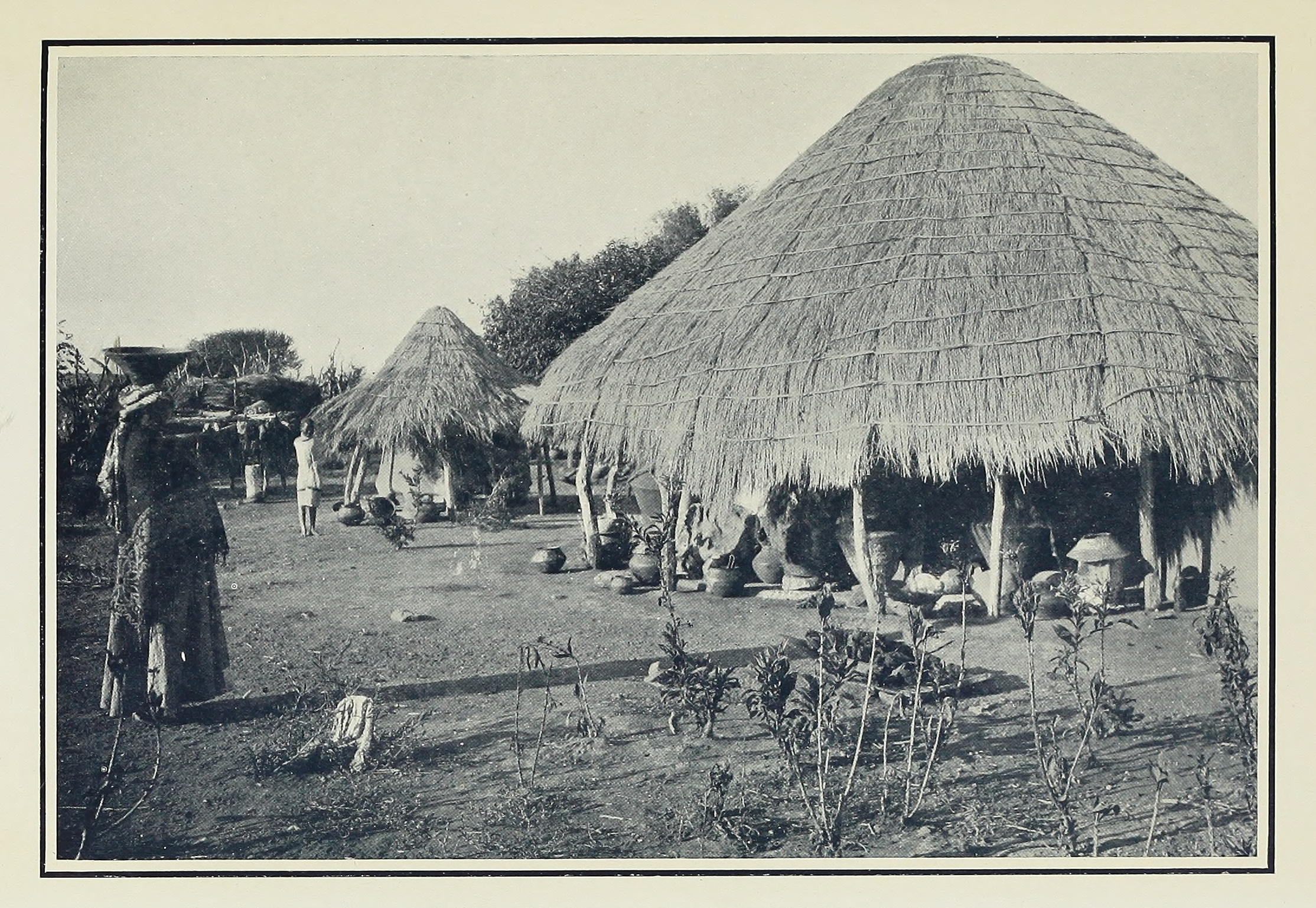
Scene in a Village of the Bechuana. Illustration from J. Tom Brown, Among the Bantu Nomads (London: Seely, Service & Co., 1926), opposite 48. Courtesy of the Internet Archive. Although Livingstone’s period in southern Africa predates this photograph, the image provides a sense of the habitations of the BaKwena and the other BaTswana groups that Livingstone regularly visited in his early missionary period.
Livingstone may have concluded that the context of his remarks permitted such language without risk of offending readers. In the wake of previous discussion of initiation rituals in missionary publications, he perhaps felt on safe ground with at least his evangelical constituency (see Moffat 1842:250, 496). Ultimately, Livingstone's decision held sway; one of the references to circumcision reappears in the published text, and his wider comments on the bogwêra are left intact (1857aa:146-47).
Despite occasional moments of divergence, the transactions between Livingstone and Milton highlight a concerted and mutual effort to comply with the social codes of polite publishing. Concerns with literary propriety and public sensibilities were decisive influences on the publication process and resulted in a distinctive pattern of literary redaction that involved authorial self-regulation and editorial correction.
3. Depoliticization: The Transvaal Voortrekkers and the BaTswana Top⤴
While Missionary Travels was subject to the protocols of politesse, the book also underwent a more surprising and significant transformation between manuscript and print. Comparison between Livingstone's manuscript and the published book reveals evidence that the narrative was considerably depoliticized during the revision process.
The political redaction of Missionary Travels involved revisions to the book's discussions of two arenas of colonial and settler politics in southern Africa: 1) the activities of the Voortrekkers in the Transvaal and their interactions with the BaTswana, and 2) the Cape Frontier Wars, a series of colonial conflicts in which British and Boer settlers fought the AmaXhosa in South Africa's Eastern Cape.
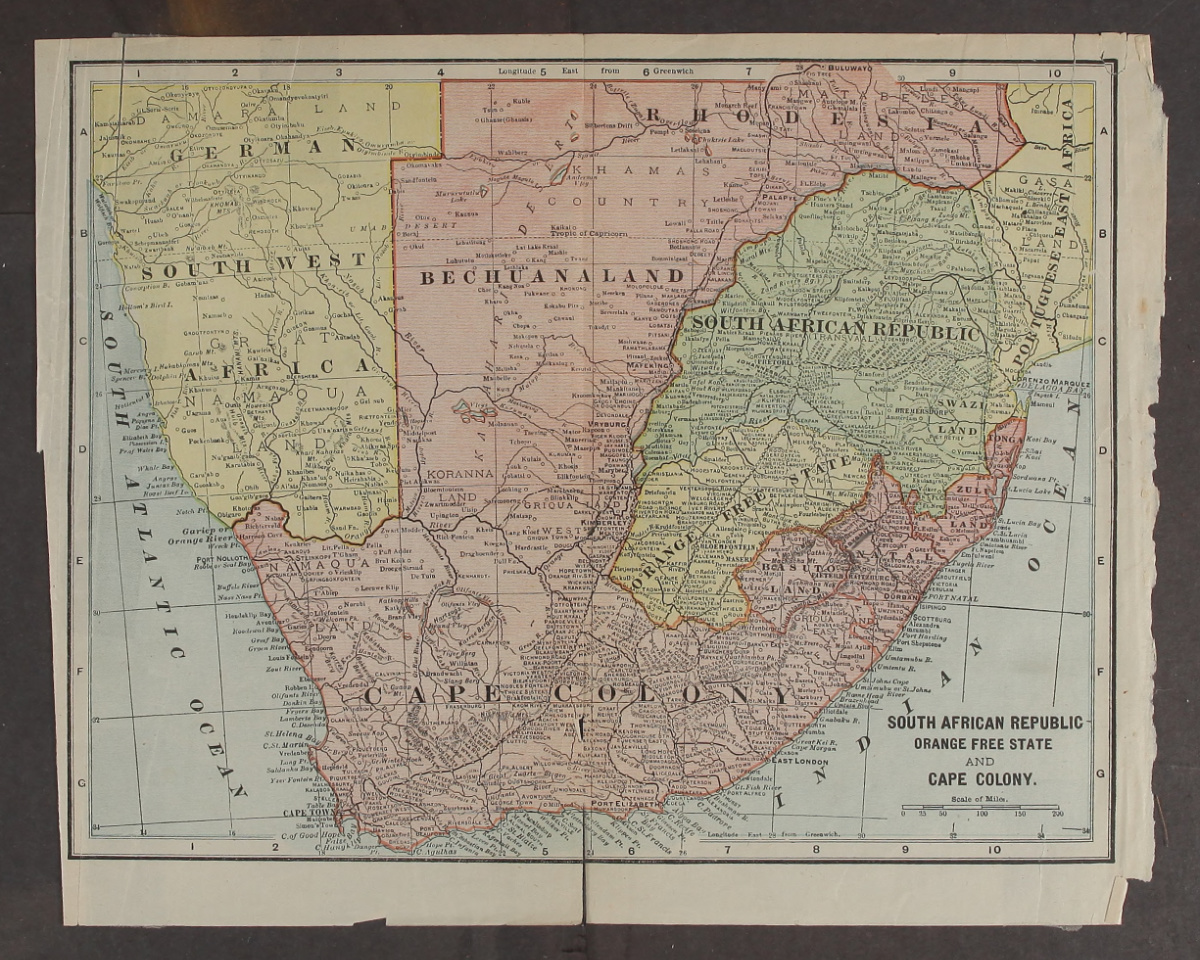
South African Republic, Orange Free State and Cape Colony. Map from Henry Houghton Beck, History of South Africa and the Boer-British War (Philadelphia: Globe Bible Publishing, 1900), n.p. Courtesy of the Internet Archive. This map details the political division of southern Africa as it existed at the end of the nineteenth century.
The Voortrekkers were a subset of the Boers that had migrated north from the Cape Colony in the 1830s and 1840s, settled beyond the confines of British rule, and later established the republics of the Transvaal (or South African Republic) and the Orange Free State. It is well known that Livingstone was critical of their activities and accused them of enslaving members of BaTswana groups and engaging in illegitimate warfare (Schapera 1960b:145). Writing in 1930, for instance, the twice Prime Minister of South Africa, Jan C. Smuts, bemoaned Livingstone's "implacable spirit" against the Transvaal Voortrekkers and noted that Livingstone "never had a good word to say about them" (Smuts 1930:6).
What has not previously been recognised, however, is that the assessment of the Transvaal that found its way into the print version of Missionary Travels had been significantly moderated during the revision process. The manuscript contains additional material which, had it appeared in the published text, would have intensified Livingstone's charges against both the Voortrekkers and Cape policy towards them.
▲ 3.1. Livingstone in the Transvaal
Livingstone used Missionary Travels to detail his experiences in the Transvaal. He spent the 1840s working at several mission stations situated near the Transvaal border. Between 1846 and 1848, he made four journeys into the region: one as far as present-day Mokopane and three others to the closer Rustenburg (Schapera 1974:3). During these trips, Livingstone became one of the earliest external eyewitnesses to the Transvaal community and its dealings with local African groups.
In the Transvaal, Livingstone certainly observed forms of slavery. Bonded or "registered labour" (known as "inboekstelsel"), through which members of African communities were conscripted as domestic servants and plantation workers, was common practice. Enforced labour and slave raiding continued until at least 1870, long after legislation prohibiting slavery was passed in the South African Republic (Morton 1992: 99-100, Laband 2005:41).
In visiting the Transvaal, Livingstone's primary agenda was to establish an African evangelist with the local BaTswana (Schapera 1974:3). Having trekked in an effort to escape the Cape influence, however, many of the Voortrekkers were suspicious of the efforts of a British missionary to begin work in Transvaal territory. This came to a head during Livingstone's fourth visit in which he had a major altercation with Andries Potgieter, the Transvaal leader. Potgieter suspected the missionary of trying to occupy land for the British government, refused Livingstone's request to establish a teacher in the vicinity, and subsequently wrote to the London Missionary Society (LMS) to request his recall from Kolobeng (Schapera 1974:21-22).
| Google map of southern Africa. This map shows the locations in southern Africa referenced in the present section and the relative proximity of these places to one another. Left to right, the locations identified are Lake Ngami (near top of map), Kuruman (near bottom of map), Dimawe Hill, Kolobeng, Rustenburg, and Mokopane. |
This collision and the inventory of accusations that Potgieter sent to the LMS (which included charging Livingstone with gun running) fueled Livingstone's antipathy towards the Transvaal (see Schapera 1974:22). However, Livingstone's hostility had long been developing as a result of escalating tensions between the Voortrekkers and the BaKwena, the BaTswana subgroup with whom he was then residing.
Since their arrival in the Transvaal, the Voortrekkers had been attempting to compel the submission of many BaTswana subgroups including the BaKwena (Ramsay 1991:193). Recognising that their own security depended on military superiority, the Voortrekkers sought to disarm local African communities and prevent access to further gun supplies. Sechele, the head of the BaKwena, was particularly resistant and refused to recognise Transvaal authority. Throughout the 1840s, he consolidated his position by actively developing his stockpile of armaments through his connections with traders, big game hunters, and missionaries (Ramsay 2014:458-59).
The Transvaal Voortrekkers' concerns about BaKwena weaponry intensified following Livingstone's journey to Lake Ngami in 1849. The expedition into Ngamiland, which had been supported by Sechele, helped facilitate a commercial route into modern-day northern Botswana that extended the regional opportunities to trade in guns. In an effort to prevent supplies reaching the BaKwena and other groups, the Voortrekkers tried unsuccessfully to restrict travel towards the lake (Ramsay 1991:194; 2014:456-57).
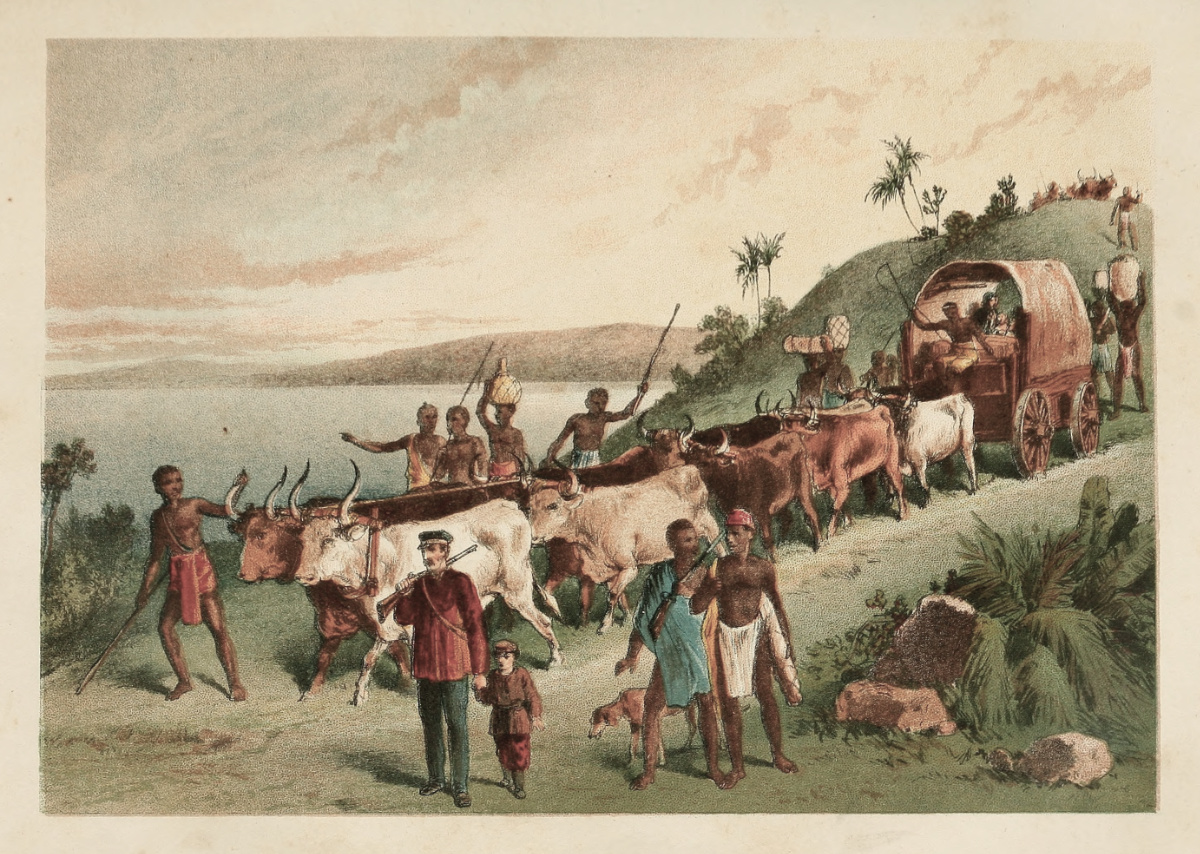
The Arrival at Lake Ngami. Illustration from John S. Roberts, The Life and Explorations of David Livingstone L.L.D. (London: John G. Murdoch, 1870), opposite 76. Courtesy of the Internet Archive. Livingstone first crossed the Kalahari to reach Lake Ngami in 1849 in the company of William Cotton Oswell and Mungo Murray. In 1850 and 1851, Livingstone made two more journeys through the Kalahari with the aim of going further north to the Makololo. On the second of these expeditions, undertaken with Oswell, Livingstone reached the Makololo and then continued north for his first sighting of the Zambezi River.
Tensions reached a critical point in late August 1852 when a Boer commando dispatched by Andries Pretorius and led by Pieter Scholtz marched on the BaKwena and demanded their surrender. In the resulting battle at the stronghold of Dimawe, the commando killed at least 60 men and took hundreds of women and children captive, but ultimately failed to conquer Sechele (Ramsay 1991: 195-96, Morton 1992:102). Despite the greater losses suffered by the BaKwena and their allies, the campaign became a key episode in the BaTswana-Boer War of 1852-53 – a conflict in which Sechele managed to resist the Voortrekkers' efforts to secure their submission (Ramsay 1991:200, 2014:468).
Livingstone was in Kuruman when all this occurred, but in the aftermath of the battle a section of the commando ransacked his mission station at Kolobeng (1857aa:118). He was incensed both by the Voortrekkers' treatment of the BaKwena and by the destruction of his own property. When it came to publishing a book, Livingstone saw an opportunity to indict the Transvaal community publicly. In Missionary Travels, he cites the Voortrekkers' "infamous treatment of natives" and contends that they conscripted the BaTswana (including the BaKwena) into forced labour, acquired domestic slaves "by forays on tribes," and generally seized "only the youngest children" (1857aa:vii, 30, 127). Livingstone decries the Voortrekkers' military tactics, which involved deploying African auxiliaries "in front, to form, as they say, ‘a shield,'" and sums up their modus operandi as "the law of the strongest" (Livingstone 1857aa:37-38).
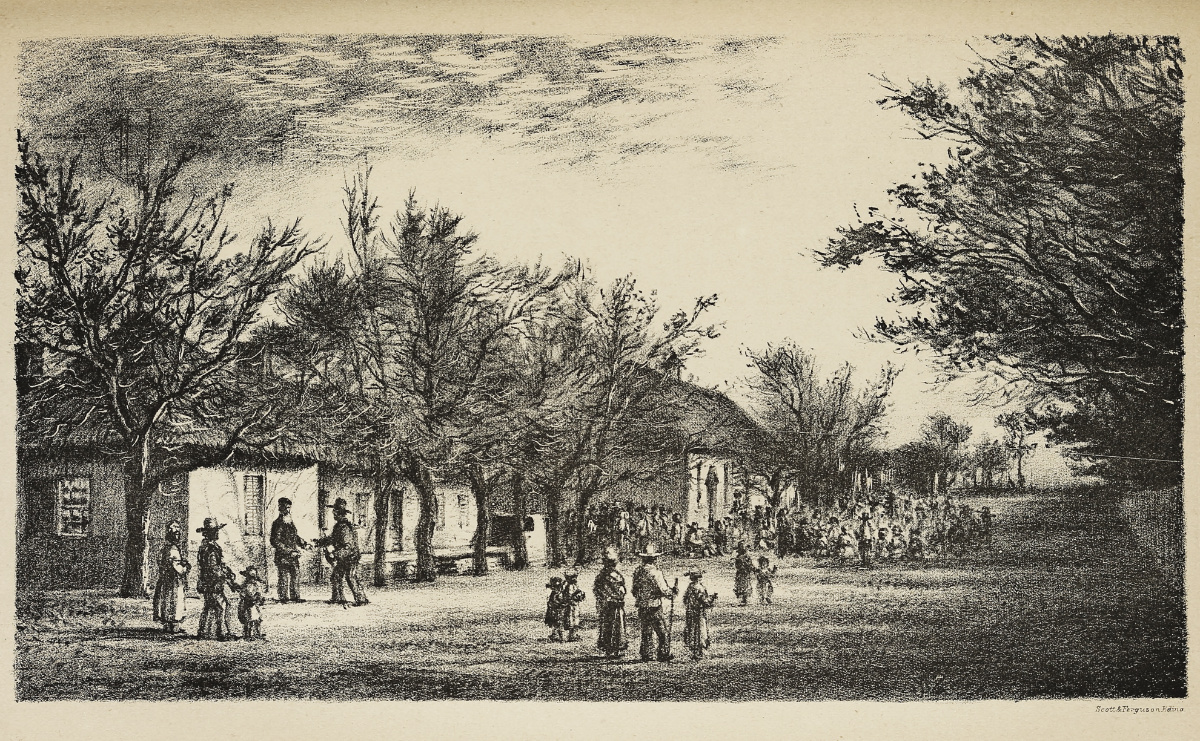
Sunday Morning at Kuruman. Illustration from John MacKenzie, Ten Years North of the Orange River (Edinburgh: Edmonston and Douglas, 1871), opposite 72. Courtesy of the Internet Archive. Kuruman was established by Robert and Mary Moffat in the 1820s as a mission to the BaTlhaping (a BaTswana group) and became the centre of London Missionary Society activities in the region. Prior to the mission stations built by Livingstone in the 1840s, Kuruman was the furthest north of the LMS missions in southern Africa.
Missionary Travels also gave Livingstone the chance to air his complaints regarding the sacking of Kolobeng. He notes how in the assault of the Boer commando, his books "were torn," his "stock of medicines was smashed," and his possessions "carried off and sold at public auction." More significantly, the book enabled him to publicise BaTswana injuries following the Battle of Dimawe, in which the Voortrekkers had "carried off two hundred of our school children into slavery" including Sechele's own son Kgari (Livingstone 1857aa:39, 125). Livingstone goes as far as to implicate recent colonial policy by arguing that the invasion had been encouraged by the Sand River Convention of 1852, which had recognised the independence of the Transvaal as a republic (1857aa:38-39, 106).
The difficult relations between the Transvaal Voortrekkers and the BaTswana that marked Livingstone's first decade in southern Africa clearly left him with serious grievances. In Missionary Travels, which would circulate widely, Livingstone thus found a powerful vehicle through which to disseminate complaints about his own ill-treatment and the oppression of the BaTswana (and particularly the BaKwena) to the wider British public.
▲ 3.2. A "chosen people" or "white savages"?
Although Livingstone's assessment of the Transvaal in the published version of Missionary Travels is highly critical, comparison between the book and the original manuscript reveals that he nonetheless tempered his published commentary in important respects. At the most basic level, the editing process de-intensified the overall impression of Voortrekker critique by reducing repetition of some of Livingstone's key claims. The redaction of the manuscript, for instance, included removing additional descriptions of child captives "bought and sold openly as slaves in the vicinity of the colony," and of "slave children who had been captured in the murderous forays" now serving in Voortrekker households (Livingstone 1857bb:[289], [296]).
The redaction process, however, did not simply remove repetition. It also resulted in the excision of material that was even more severe in its denunciations of the Voortrekkers than comparable passages in the published text (see Livingstone 1857bb:[294]-[297] for the later excised material). This is undoubtedly the case with Livingstone's comments about the politico-religious identity of the Voortrekkers which he perceived to be rooted in a Calvinist theology of predestination and election.
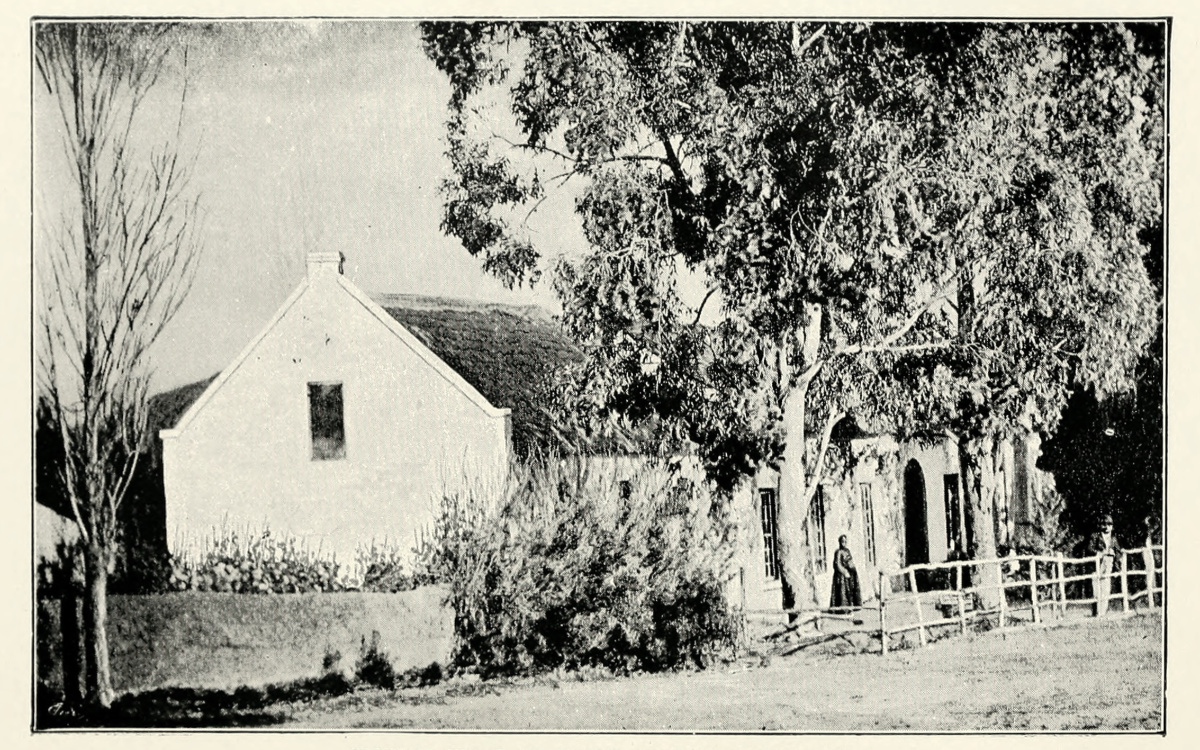
Common Style of South African Farmhouse. Illustration from John S. Moffat, The Lives of Robert & Mary Moffat (London: Fisher Unwin, 1885), 92. Courtesy of the Internet Archive. The mid-nineteenth-century Boer households that Livingstone visited in the Transvaal would have been similar in design to the farmhouse above.
In the published book, Livingstone touches on the subject of politico-religious identity by suggesting that the Voortrekkers were convinced of their divinely sanctioned status: "They being the chosen people of God, the heathen are given to them for an inheritance, and they are the rod of divine vengeance on the heathen, as were the Jews of old" (1857aa:31). Yet the extent to which Afrikaners actually conceived of themselves as being a "Chosen People with a divine mission" prior to the 1880s is the subject of some debate (Giliomee 2003:178; also see Bosch 1984, du Toit 1983). In the Transvaal, Livingstone would doubtless have encountered settlers who held to such a theology, but not in the widespread fashion that his statement implies; in the nineteenth century "[t]he 'chosen people' theology was by no means a mainstream doctrine or a source of common inspiration" (Giliomee 2003:179).
Nevertheless, Livingstone pushes his criticism of "chosen nation" theology one step further in the Missionary Travels manuscript. He does so by ridiculing Boer biblical interpretation and suggesting that the Transvaal Voortrekkers made unfounded connections between their own territory and the geography of the Old Testament:
The boundaries which I have heard them gravely assign to their territory are rather vague for their general ideas of geography are derived from an old map placed in the large old copies of the Bible left them by their forefathers[.] This shews the Latitude & Longitude of the garden of Eden – The Pillars of Hercules and perhaps the bedstead of of [sic] King of Bashan – And being in the Bible is of course quite true – Jerusalem being apparently near forms the Northern boundary of the Transvaal Republic[.] (Livingstone 1857bb:[295])
In another redacted comment elsewhere in the manuscript, Livingstone similarly quips that in "the ancient map in their old bibles [the Voortrekkers] see that Canaan and Cashan are not far apart." Since the Voortrekkers viewed themselves as "God's own people," Livingstone argues, their confused geography provided them with warrant to "claim right up to Jerusalem" (1857bb:[81]).
It is probable that Livingstone based his remarks on the "Jerusalemgangers," a Voortrekker sect which aimed to navigate its way to the Promised Land guided by the map printed in the Dutch State Bible (Bosman 2014:152, Schapera 1974:85n26). Although this use of the Bible was by no means widespread, Livingstone portrays the intermingling of southern African and scriptural geography as characteristic of Boer theology. He seems to generalise from a particularly conspicuous instance of chosen people theology in order to lampoon Afrikaner Christianity more widely and to highlight what he calls the "lamentable ignorance" of the Transvaal residents (Livingstone 1857bb:[295]). By removing this satire of biblical interpretation from the published book, Livingstone stepped away from some of his more scathing comments about the Transvaal community.
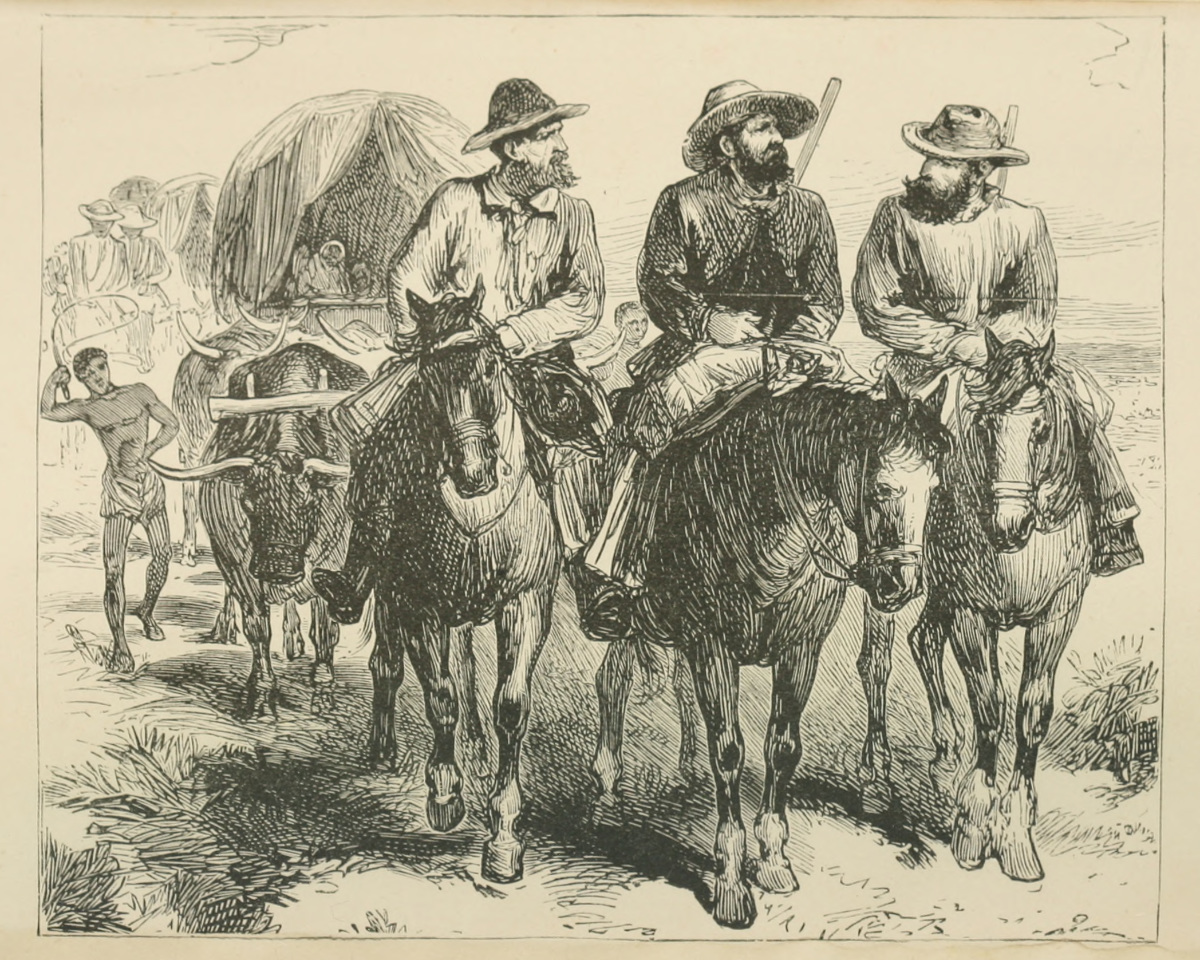
The Vee Boers. Illustration from Mayne Reid, The Vee-Boers: A Tale of Adventure in Southern Africa (London: George Routledge and Sons, 1885), frontispiece. Courtesy of the Internet Archive. Although Livingstone had considerable influence on popular opinion in Britain about the Boers, other perspectives circulated. The Victorian children’s novelist, Mayne Reid, heroised the Voortrekkers in an adventure book for boys, as exemplified in this illustration.
Likewise, the redactions to Missionary Travels ensured that some quite inflammatory commentary on the cultural conditions of the Voortrekkers would not appear in print either. For instance, in his manuscript, Livingstone describes this group of European settlers in terms that missionaries usually reserved for the African groups they were attempting to reach. In one passage, he complains that reports on the Transvaal from the Dutch Reformed Church had sought to "avoid an exposure of [the Voortrekkers'] degradation." He also suggests that by turning a blind eye to the condition of the Voortrekkers, the Dutch clergy had failed in the missionary's duty "to reveal the real state of his people" (Livingstone 1857bb:[297]).
Livingstone contrasts himself with the Dutch clergy by claiming that he has "now attempted this in reference to these poor degraded interior Boers" (1857bb:[297]). Emphasising his candour, Livingstone positions his own assessment of the Voortrekkers as a more honest missionary report on their condition. He also uses less restrained language than in the published book to argue that in the absence of "a minister or missionary," the Transvaal Boer community had degenerated culturally and now required remedial intervention: "I now say, they assuredly need the sympathy and aid of their own church to prevent them sinking into utter barbarism" (1857bb:[297]).
For Livingstone, the Voortrekkers were not culturally superior to the region's African inhabitants and were equally in need of European evangelism. In a surprising reversal of racial stereotypes, he declares: "No mission to the blacks ought to be undertaken by the Dutch untill [sic] they have supplied these children of pious parents – These now white savages with the light of Christianity" (Livingstone 1857bb:[297]). Such explicit comments, however, were kept out of the published Missionary Travels.
| (Left; top in mobile) Letter to Robert Moffat I with Speech (Sechele and Livingstone 1852:[1]-[2]). Images from SOAS Library, University of London. Images copyright Council for World Mission. Used by permission for private study, educational or research purposes only. Please contact SOAS Archives & Special Collections on [email protected] for permission to use this material for any other purpose. As relevant, copyright Dr. Neil Imray Livingstone Wilson. Creative Commons Attribution-NonCommercial 3.0 Unported. This is Livingstone’s translation of a letter written by the BaKwena chief, Sechele, after the Battle of Dimawe in 1852. The battle pitted the BaKwena against the Boers. Livingstone included most of this letter, which provides Sechele’s account of the Boers’ military campaign, in Missionary Travels (see Livingstone 1857aa:118-19) |
During the period in question, Livingstone had made other attempts to publicize his displeasure with the Voortrekkers. In 1853, he had drafted a long and highly critical article on Transvaal slavery in which he complained about the "degradation of these Transvaal Boers" and their "rapid strides to downright savageism" (Livingstone 1974a:86, 83). In this piece, as in the Missionary Travels manuscript, Livingstone parodies the scriptural geography of the Voortrekkers who "believe that they, as the chosen people of God, are travelling to the land of Canaan" (Livingstone 1974a:84-85). Yet although the article was intended for The British Quarterly Review, it remained unpublished until after Livingstone's death (Schapera 1974:67-68; the essay was printed in Blaikie 1881:490-511 and republished in Schapera 1974:70-95).
Other vehement criticisms of the Voortrekkers did appear in print during Livingstone's life, albeit not under his own name. In 1849, he anonymously published two articles in the evangelical British Banner sharing the title "The Peace Makers of the Interior" (Livingstone 1974b, 1974c), a designation that he applied ironically to the Transvaal community. In one of these pieces – to give a representative example – he refers to the Voortrekkers as "white thieves" and describes their slave excursions as "the depredations of the White Caffre" (Livingstone 1974b:13-14). As Schapera observes (1974:2), Livingstone recognised that in these polemical articles he had used "language which those at a distance may have thought overcharged."
In editing his travelogue, Livingstone chose to remove material that he had previously reserved for an abolitionist publication where he could expect a sympathetic audience familiar with his emotive language. In a more public venue, where anonymity was not an option, he decided to show greater discretion. Missionary Travels has been described as among the first books to bring "to the world's attention the emigrant Dutch or 'Boer' settlers of the Transvaal colony" (Parsons 1998:31). In its published state, the book was certainly an exposé document but in a more circumscribed, less critical form than Livingstone had once envisaged and drafted.
▲ 3.3. Colonial Officials and the Sand River Convention
Editing Missionary Travels' commentary on the Transvaal, however, did not only involve moderating remarks about the Voortrekkers. Additional material found in the manuscript indicates that Livingstone also carefully tempered his critical assessment of colonial policy and the actions of colonial officials – both of which he considered to bear some responsibility for slavery in the Transvaal and for his own experience at the hands of the Voortrekkers.
The Missionary Travels manuscript actually opens with a draft of a letter to the colonial secretary, Henry Labouchere, in which Livingstone complains about the Transvaal "Rebels" and the terms of the Sand River Convention (1857bb:[1]-[3]). Livingstone may have considered including the letter in the published book in order to showcase his efforts in lobbying the political establishment, or he may have simply intended it to serve as an aide memoire when drafting later material. Regardless, the letter's prominent position at the beginning of the manuscript indicates just how significantly the Transvaal Voortrekker community, its military action against Sechele, and recent colonial policy figured in Livingstone's mind as he began drafting Missionary Travels.
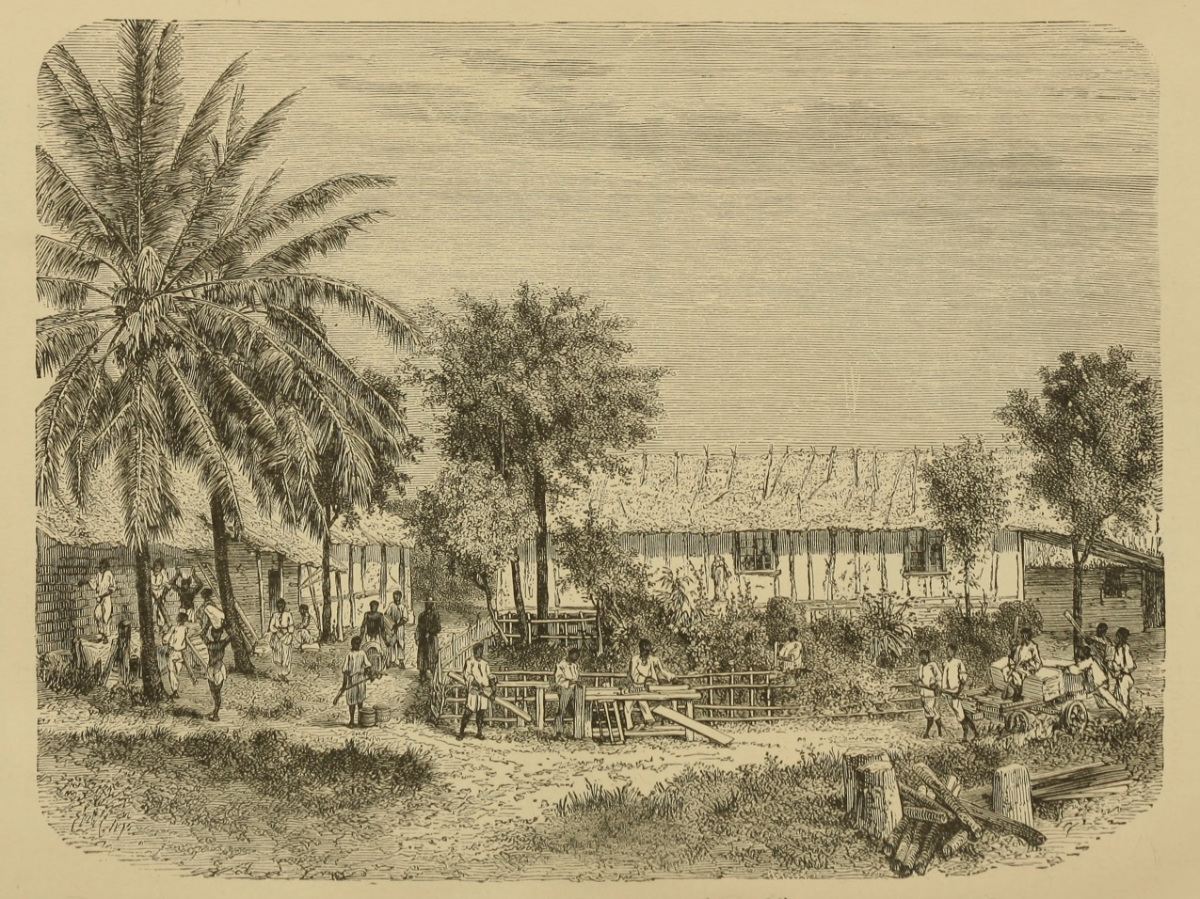
Mission Station, Kolobeng. Illustration from J. E. Chambliss, The Life and Labors of David Livingstone, LL.D., D.C.L. (Philadelphia, Boston, and Cincinnati: Hubbard Bros., 1875), 75. Courtesy of the Internet Archive. Kolobeng was established in 1847 to the south-east of present-day Gaborone, Botswana. This was Livingstone’s third station and succeeded his previous missions at Mabotsa and Chonuane. The ruins of the Kolobeng station survive to the present-day.
The manuscript also contains a later ten-page passage on the Transvaal (1857bb:[288]-[297]), much of which is absent from the published text. In the first few pages, Livingstone covers similar ground to a discussion that appears earlier in the manuscript (1857bb:[78]-[81] ) and which also appears in the published Missionary Travels (1857aa:38-39). This redacted passage repeats the charges that Livingstone had already made about the Voortrekkers' "expedition against Sechele," their destruction of his residence at Kolobeng, and their "practice of slave hunting" (Livingstone 1857bb:[289], [291]; also see above).
In itself, the impetus to revisit these sentiments and events could signal the impact that the attack on Sechele and developments in the Transvaal had had on Livingstone; it was perhaps his ongoing preoccupation with the "200 of the children most of whom I could have identified as belonging to our schools" (1857bb:[289]) that compelled him to re-narration.
However, in resuming his discussion of the Transvaal, Livingstone might also have been gauging how far to extend his critique. In the redacted passage, Livingstone takes the opportunity to formulate a more robust criticism of Sir George Cathcart, the Cape governor who had approved the Sand River Convention shortly after taking office and who had been in post when Sechele was attacked. Livingstone recounts how, in the aftermath of the invasion, he had "volunteered to Sir George Cathcart to identify the school children consigned […] to hopeless slavery." The answer received, however, was simply: "such was the fortitude of war" (1857bb:[290]-[291]).
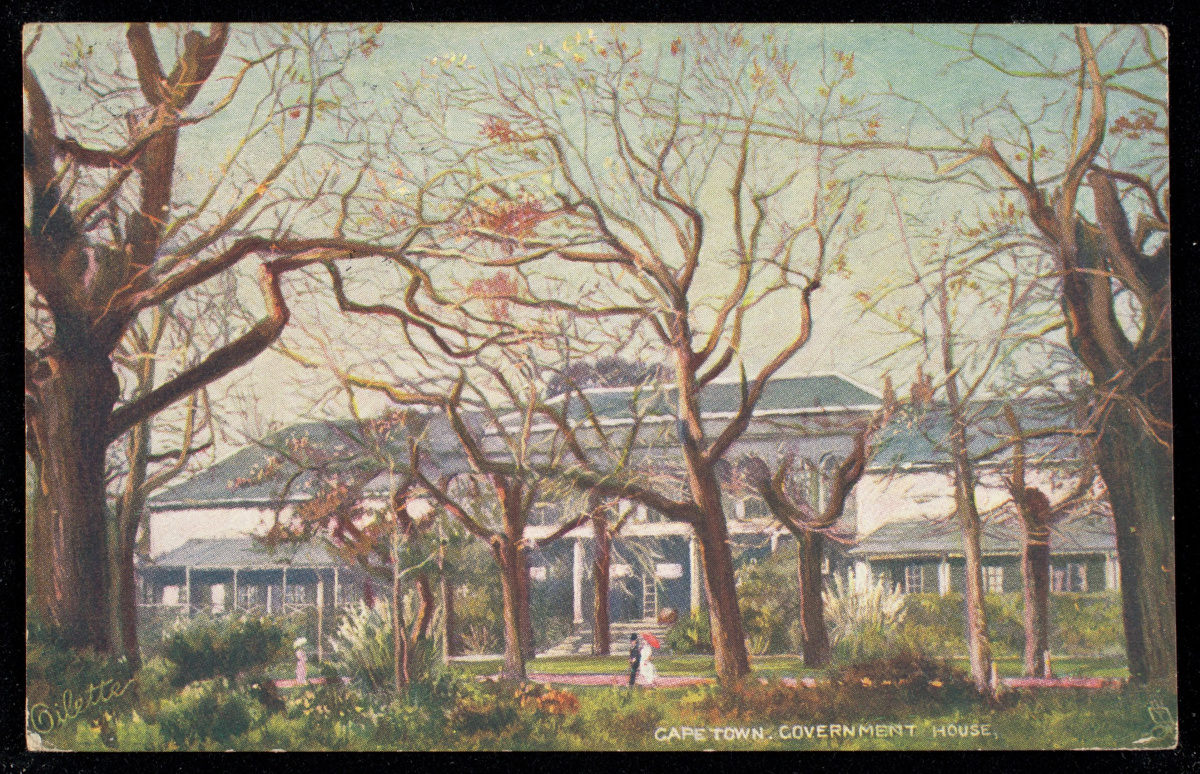
Postcard of Government House, Cape Town. Raphael Tuck & Sons, c. 1910. Courtesy of the Internet Archive. Built in the 1790s, the Government House historically served as an official residence of the Governor of the Cape. It was also the location of the first Cape Parliament held in 1854.
Livingstone was clearly rankled at being summarily dismissed and, in the redacted passage, fantasizes about confronting the governor:
I was then in my way to the North or I should have raised a question which could not have been answered so cavalierly, As the Boers were notoriously intent on the practice of slave hunting and slavery, whether a policy favourable to this system directly at variance with the general policy of the English Government would not subject the commander himself to refund the losses thereby sustained by British subjects[.] (Livingstone 1857bb:[291])
The question Livingstone imagines posing to Cathcart is clearly designed to implicate the governor in the recent events in the Transvaal. Livingstone knew that the prohibition of slavery was a condition of the Sand River Convention, but felt that the practice continued to run unchecked in the Transvaal and had actually been heightened by the state's independence (1857aa:127). In refusing to act in response to the enslavement of the BaKwena – Livingstone suggests in the manuscript – Cathcart was really guilty of contravening British opposition to slavery.
| (Left; top in mobile) Major-General the Hon. George Cathcart, the Newly-Appointed Governor and Commander-in-Chief of the Cape of Good Hope. From a Daguerreotype by Claudet. Illustration from Illustrated London News, 7 February 1852, 125. Courtesy of the Hathi Trust. (Right; bottom) Image of a page from the Missionary Travels manuscript (Livingstone 1857bb:[291]). Copyright National Library of Scotland and Dr. Neil Imray Livingstone Wilson (as relevant). Creative Commons Share-alike 2.5 UK: Scotland. The criticisms of George Cathcart on this manuscript page are marked up both by Livingstone and the editor, John Milton. The question mark and initials at margin left are in Livingstone’s hand. Milton’s marginal comment in red ink consists of an abbreviation of the word “query” along with “stet,” a proof correction mark for “let it stand.” The precise meaning of Milton’s annotation is unclear, but it is evident that he had reservations about retaining the passage. |
Having drafted this retrospective challenge, Livingstone adds a rather barbed comment. Had he confronted the governor as he would have liked, Livingstone muses, he might not have received damages for his losses but he would have "taught a great man that it was scarcely safe to despise the meanest missionary" (1857bb:[291]). Although the passage proceeds to pay tribute to Carthcart's service in the Crimean War and "the uprightness of his intentions," Livingstone clearly suspected he had gone too far (1857bb:[292]). He brackets the dubious comment with a long line and places a question mark (with his initials) in the margin. Livingstone's concerns were apparently shared by the editor, Milton, who adds his own textual notation to indicate that he too queried printing the passage (1857bb:[291]).
Ultimately, the published Missionary Travels shies away from such direct critique. In fact, although Cathcart is named on three occasions in the published text (Livingstone 1857aa:38, 106, 114), there are several other references from the manuscript that have been removed or are replaced with the more judicious attribution "the governor" (see Livingstone 1857bb:[210], [217], [299], [313] for the elided references). Doubtless, Livingstone was influenced by Cathcart's status as a hero who had died in service during the Crimean War. Yet Livingstone was clearly also wary of criticising and defaming a major colonial official in the public forum of his much-anticipated book.


![John Murray III and Anon., David Livingstone - Boat Scene (Painted Magic Lantern Slide), [1857], detail. Copyright National Library of Scotland, CC BY-NC-SA 2.5 SCOTLAND. John Murray III and Anon., David Livingstone - Boat Scene (Painted Magic Lantern Slide), [1857], detail. Copyright National Library of Scotland, CC BY-NC-SA 2.5 SCOTLAND.](https://livingstoneonline.org:443/sites/default/files/section_page/carousel_images/liv_014067_0001-carousel.jpg)
![Image of two pages from Livingstone's Field Diary XVI (Livingstone 1872h:[2]-[3]). CC BY-NC 3.0 Image of two pages from Livingstone's Field Diary XVI (Livingstone 1872h:[2]-[3]). CC BY-NC 3.0](https://livingstoneonline.org:443/sites/default/files/section_page/carousel_images/liv_000016_0003-carousel.jpg)





![David Livingstone, Map of Lakes Nyassa and Shirwa [1864?], detail. Copyright National Library of Scotland, CC BY-NC-SA 2.5 SCOTLAND; Dr. Neil Imray Livingstone Wilson, CC BY-NC 3.0 David Livingstone, Map of Lakes Nyassa and Shirwa [1864?], detail. Copyright National Library of Scotland, CC BY-NC-SA 2.5 SCOTLAND; Dr. Neil Imray Livingstone Wilson, CC BY-NC 3.0](https://livingstoneonline.org:443/sites/default/files/section_page/carousel_images/liv_000077_0001-tile.jpg)

![Victoria Falls. Image from Lantern Slides of the Life, Adventures, and Work of David Livingstone (London Missionary Society c.1900:[3]). Images courtesy of the Smithsonian Libraries, Washington, D.C. Victoria Falls. Image from Lantern Slides of the Life, Adventures, and Work of David Livingstone (London Missionary Society c.1900:[3]). Images courtesy of the Smithsonian Libraries, Washington, D.C.](/sites/default/files/in-his-own-words/missionary-travels-manuscript/missionary-travels-in-pen-and-print-1/liv_012010_0029-article-1200.jpg)
![Livingstone Sees the Queen. Image from Lantern Slides of the Life, Adventures, and Work of David Livingstone (London Missionary Society c.1900:[4]). Images courtesy of the Smithsonian Libraries, Washington, D.C. Livingstone Sees the Queen. Image from Lantern Slides of the Life, Adventures, and Work of David Livingstone (London Missionary Society c.1900:[4]). Images courtesy of the Smithsonian Libraries, Washington, D.C.](/sites/default/files/in-his-own-words/missionary-travels-manuscript/missionary-travels-in-pen-and-print-1/liv_012010_0031-article-1200.jpg)
![Image of a page segment from the Missionary Travels manuscript (Livingstone 1857bb[312]), detail. Copyright National Library of Scotland and Dr. Neil Imray Livingstone Wilson (as relevant). Creative Commons Share-alike 2.5 UK: Scotland (https://creativecommons.org/licenses/by-nc-sa/2.5/scotland/). Image of a page segment from the Missionary Travels manuscript (Livingstone 1857bb[312]), detail. Copyright National Library of Scotland and Dr. Neil Imray Livingstone Wilson (as relevant). Creative Commons Share-alike 2.5 UK: Scotland (https://creativecommons.org/licenses/by-nc-sa/2.5/scotland/).](/sites/default/files/in-his-own-words/missionary-travels-manuscript/missionary-travels-in-pen-and-print-1/liv_000099_0312-article-crop-1200.jpg)
![Letter to Robert Moffat I with Speech (Sechele and Livingstone 1852:[1]). Images from SOAS Library, University of London. Images copyright Council for World Mission. Used by permission for private study, educational or research purposes only. Please contact SOAS Archives & Special Collections on docenquiry@soas.ac.uk for permission to use this material for any other purpose. As relevant, copyright Dr. Neil Imray Livingstone Wilson. Creative Commons Attribution-NonCommercial 3.0 Unported (https://creativecommons.org/licenses/by-nc/3.0/). Letter to Robert Moffat I with Speech (Sechele and Livingstone 1852:[1]). Images from SOAS Library, University of London. Images copyright Council for World Mission. Used by permission for private study, educational or research purposes only. Please contact SOAS Archives & Special Collections on docenquiry@soas.ac.uk for permission to use this material for any other purpose. As relevant, copyright Dr. Neil Imray Livingstone Wilson. Creative Commons Attribution-NonCommercial 3.0 Unported (https://creativecommons.org/licenses/by-nc/3.0/).](/sites/default/files/in-his-own-words/missionary-travels-manuscript/missionary-travels-in-pen-and-print-1/liv_003027_0001-article-1200.jpg)
![Letter to Robert Moffat I with Speech (Sechele and Livingstone 1852:[2]). Images from SOAS Library, University of London. Images copyright Council for World Mission. Used by permission for private study, educational or research purposes only. Please contact SOAS Archives & Special Collections on docenquiry@soas.ac.uk for permission to use this material for any other purpose. As relevant, copyright Dr. Neil Imray Livingstone Wilson. Creative Commons Attribution-NonCommercial 3.0 Unported (https://creativecommons.org/licenses/by-nc/3.0/). Letter to Robert Moffat I with Speech (Sechele and Livingstone 1852:[2]). Images from SOAS Library, University of London. Images copyright Council for World Mission. Used by permission for private study, educational or research purposes only. Please contact SOAS Archives & Special Collections on docenquiry@soas.ac.uk for permission to use this material for any other purpose. As relevant, copyright Dr. Neil Imray Livingstone Wilson. Creative Commons Attribution-NonCommercial 3.0 Unported (https://creativecommons.org/licenses/by-nc/3.0/).](/sites/default/files/in-his-own-words/missionary-travels-manuscript/missionary-travels-in-pen-and-print-1/liv_003027_0002-article-1200.jpg)
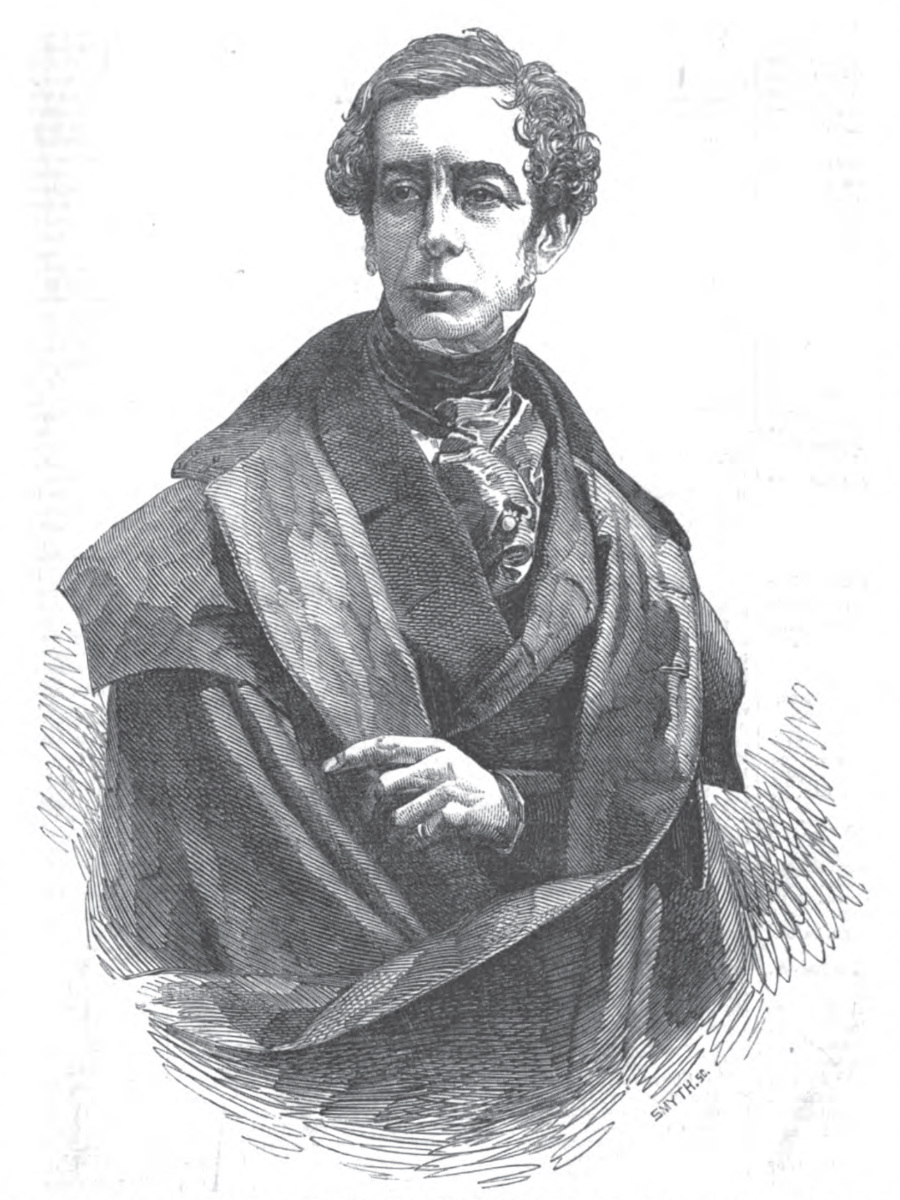
![Image of a page from the Missionary Travels manuscript (Livingstone 1857bb:[291]). Copyright National Library of Scotland and Dr. Neil Imray Livingstone Wilson (as relevant). Creative Commons Share-alike 2.5 UK: Scotland (https://creativecommons.org/licenses/by-nc-sa/2.5/scotland/). Image of a page from the Missionary Travels manuscript (Livingstone 1857bb:[291]). Copyright National Library of Scotland and Dr. Neil Imray Livingstone Wilson (as relevant). Creative Commons Share-alike 2.5 UK: Scotland (https://creativecommons.org/licenses/by-nc-sa/2.5/scotland/).](/sites/default/files/in-his-own-words/missionary-travels-manuscript/missionary-travels-in-pen-and-print-1/liv_000099_0291-article-1200.jpg)